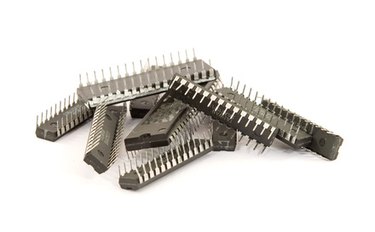
A microprocessor manipulates data in a computer system. The central processing unit acts as the brain of a computer and consists of one or more microprocessors made up of several thousand transistors on a single integrated circuit. The microprocessor works in conjunction with other parts of the computer to compute arithmetic and logic functions to handle tasks using an instruction set to perform all tasks within a computer.
Input and Output
Video of the Day
The microprocessor accepts input from devices, such as a mouse, keyboard or scanner, and performs a function on that data. It makes a decision based on the data, the microprocessor computes the information and then it sends the results to the output devices, such as a monitor or printer, as readable information for the user. For example, if a user using a word processor presses "m" on the keyboard, the microprocessor will accept that and send the letter "m" to the monitor.
Video of the Day
Arithmetic Logic Unit
The arithmetic logic unit gathers information as input from the CPU registers and operands and then does the arithmetic operations (addition, subtraction, multiplication and division) and logic operations (AND, OR and XOR). During data processing, the ALU tests conditions and prepares to take different actions based on results. The ALU also gathers data from additional sources, including number systems, instructions, timing and data routing circuits, such as adders and subtracters.
Memory
The microprocessor accesses and stores binary instructions into memory, or circuits that store bits. Random access memory is a control memory that uses registers to temporarily store data. The microprocessor stores volatile data used by programs in RAM. Read-only memory stores data permanently on chips with instructions built in. It takes longer to access the information in ROM, but it does not lose information when a computer shuts down as does RAM.
Control Unit
The control unit directs the flow of operations and data by selecting one program statement at a time, interpreting it and sending messages to the ALU or registers to carry out the instruction. It also decides where to keep information in memory and which devices to communicate with by interfacing with the ALU, memory and input/output devices. The control unit can also shut down a computer if it or another device, such as the power source, detects abnormal conditions.
Information Exchange
The system bus connects the microprocessor to the peripherals, such as a keyboard, mouse, printer, scanner, speaker or digital camera. The microprocessor sends and receives data through the system bus to communicate with the peripherals. It only communicates with one peripheral at a time so as to not mix up any information and send it to the wrong place. The control unit controls the timing of the information exchange.